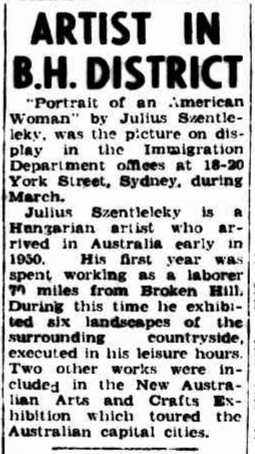Last week I shared 2 beautiful original oil paintings depicting a striking Australian outback scene. I asked the question at the end of the post if we knew who the artist was?

Well, as you can see our artists name is Julius Szentleleky. So what do we know about him? Well, a google and trove search only yields 4 results with any relevance.
The earliest, from the Sydney morning herald and dating from 1952 reads –
Show By Julius
The small paintings by Julius Szentleleky at the Grosvenor galleries are quite charming studio gleanings of little consequence in themselves, but of value to the artist.
His large pictures show that forced tonality to be seen alike in primitive and tired painting.
One feels that he can do much better, that indeed it would be unfair to criticise at present. In his sketches there is the material, and some ability. Once the scene has been absorbed, the work of art may follow which, one trusts, will be soon.
This show will be opened by Mrs. Quentin Stanham at 3 p.m. today.
The second chronologically listed newspaper article is shown below.
And thats it, all that I can currently find online about our artist, up until 2005 where the Heide Museum of Modern Art added one of Julius’ artworks to their collection –
- Szentleleky, Julius Peer gynt 1953 oil on composition board 71.9 x 54.6 cm
So where does that leave us with our 2 paintings? Well we know he was active during the early 1950’s, which does appear to conflict with the $60 price tag on the rear of one painting (as decimal currency didn’t come about until 1963) however this could be easily enough explained – perhaps he wanted to move on some of his art later on in life (shed clean out/exhibiting in a small gallery somewhere, etc). The trip to Broken Hill is interesting as it does state he painted, and exhibited landscapes of the surrounding countryside, whilst the Sydney article talks about ‘the small paintings’ – very much like these 2. The ‘oil on composition board’ painting that the Heide Museum acquired dating from 1953 also matches the medium of these 2 paintings.
So with all that information I’m pretty confident to say that these 2 paintings would date from the 1950’s and are original works. It’s nice to know a little of the story of the artist behind the artwork. Whether or not it adds value to the item I think is insignificant, it’s the link that each one of us build in our own way that matters most.





